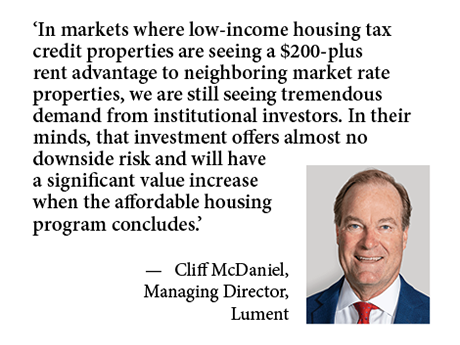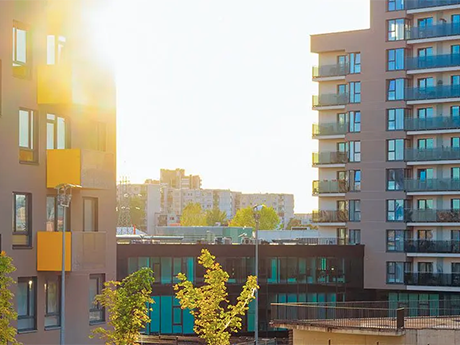Today’s accelerating technology transformation is altering how the commercial real estate industry executes transactions and manages assets. “The amount of information that a multifamily borrower needs to submit and disclose has become more demanding over time,” says William (Bill) Hyman, a Lument senior managing director who oversees the firm’s strategic business technology transformation and conventional loan production. “That has made due diligence more complex and data intensive, and we wanted to create a more secure and expedient way to tackle that process.” Seeing this need, Lument responded by creating a suite of proprietary technology tools. Across the industry, the advent of online, friendlier multifamily loan application and servicing processes has not only eliminated the transfer of sensitive information through email by moving the processes to secure portals, but it has also streamlined common paper-based, time-consuming and burdensome tasks. That has translated into much speedier decisions about loans and responses to questions and requests. LeapOnline Beginnings Lument is a commercial real estate finance solutions provider based in New York that specializes in Fannie Mae, Freddie Mac, Federal Housing Administration and balance sheet lending. The company’s digital transformation began in 2017. At the time, the company saw the opportunity to better …
Video
AcquisitionsAffordable HousingContent PartnerFeaturesLumentMidwestNortheastSoutheastTexasVideoWestern
Higher Interest Rates Cause Affordable Housing Values to Return to Old Norms
Rising interest rates dinging commercial real estate and multifamily assets have plunged low-income housing tax credit (LIHTC) properties back into reality, especially those coming to the end of their 15-year compliance periods. “There were some huge profits made in the affordable housing space over the last two or three years,” says Cliff McDaniel, a managing director with Lument, which is representing Harmony Housing in the $1.4 billion sale of its affordable housing portfolio to the Michaels Organization. “We sold a lot of properties for $60,000 a unit or even $120,000 a unit, and the debt was $40,000 a unit. But the mania over that type of profitability is over, and values are going back to where they were before.” Up until about five years ago, the phrase “huge profits” and “affordable housing” would rarely if ever have occurred in the same sentence. Or even in the same story. Prior to that, affordable housing properties typically had very little value at the end of their initial 15-year compliance periods, and limited partners who provided equity to the project by buying tax credits routinely agreed to sell their interest to the general partner for a nominal fee. At that point, the …
On Oct. 12, France Media hosted the “The Future of Multifamily Advertising is Here: How Automation is Transforming Housing” webinar, sponsored by Conversion Logix. A growing need for marketing automation in the industry means organizations are looking for improved tools and technology. Curious about how to mesh Google ads and social media video ads, retargeting campaigns, website experiences, virtual tours, emails and more into a coherent marketing approach for multifamily? Want to learn more about engagement personalization? Hear how to prepare your organization for marketing automation and make the most of the data you collect. Watch this brief webinar for tips, tricks and tech. “The multifamily marketing landscape continues to evolve,” says Crystal Banegas, new business development manager at Conversion Logix. She explains that as the world of marketing technology expands, marketers need to evolve as well to best take advantage of time-saving, personalizing technology that frees marketers to look at their advertising strategically — using real-time data to personalize (but not pester) leads. Click to listen. A copy of the webinar presentation may be downloaded here. See a list of major topics covered below: Integration of real-time data — sharing information useful to Teams Vendors Organizations Making the best use …
Affordable HousingContent PartnerDevelopmentFeaturesGeorgiaLumentMidwestMultifamilyNortheastSoutheastTexasVideoWestern
Utilizing Tax Credits to Create Affordable Housing in High-Opportunity Communities
The Section 42 Low-Income Housing Credit program has been America’s primary tool in the effort to construct affordable homes for low- and moderate- income households and ease renter cost burdens since 1986. This public-private partnership has created or preserved more than 3.1 million rental units, accounting for over 30 percent of the nation’s affordable housing stock. Congress is considering legislation that would materially expand and strengthen the tax credit program. In addition to several technical changes to tax credit accounting and rules governing the use of private-activity bond financing, the legislation would authorize increases in credit allocation in 2021 and 2022. The impact of these changes would be substantial, catalyzing construction of more than 100,000 additional units per year over a 10-year period, perhaps trimming the number of rent burdened low-income households by half. Building more affordable housing will represent a significant step toward reducing housing instability and economic inequality in America. But are quantitative gains alone enough? Constructing affordable housing in low-poverty, high-opportunity census tracts is challenging. The following discussion explores some ways in which developers, lenders and credit allocating agencies can increase the level of affordable housing construction in low-poverty, high-opportunity areas (LPHOA) and optimize the …
In 2021, supply chain issues, increased costs, wage inflation and the logistical challenges of completing projects compounded to negatively impact the affordable housing pipeline. According to Gregg Gerken, head of U.S. Commercial Real Estate with TD Bank, 2022 looks fantastic for the affordable housing sector as those issues are beginning to resolve. However, he notes that the affordable housing sector is still challenged by delays related to financing challenges, among other factors. Demand for affordable housing, federal level commitments to the sector and the continued involvement of Fannie Mae and Freddie Mac are all positive factors for the outlook of affordable housing. However, Gerken notes, “Financing is somewhat challenged by gaps in funding. With pricing and costs going up, there’s a gap between how much a project might support from a loan side versus how much in tax credits are allocated to that project during the last round of allocations. Some of that gap between overall costs and the funding sources is being made up as local agencies put in additional money in order to get affordable housing done.” Hear what Gerken has to say about the development of workforce and affordable housing and the involvement of government-sponsored …
Content PartnerFinance InsightLoansMidwestMultifamilyNortheastSoutheastTexasVideoWalker & DunlopWestern
Web-Based Appraisal Tool Supports Massive Increase in Demand for Multifamily Valuations
Multifamily appraisers are extremely busy as investor interest in the sector is at an all-time high. “In terms of appraisal professionals, there is a supply and demand issue,” explains Meghan Czechowski, managing director and valuation lead for Apprise by Walker & Dunlop. She notes that the industry has greater demand for valuation than it has qualified appraisers. “Apprise is ensuring that we can support our appraisal staff and our local market experts with a tech-enabled process so that they can do their jobs more efficiently and get the values (and market information in general) into our clients’ hands as quickly as possible,” she adds. Czechowski focuses on the ways that web-based multifamily valuations can be streamlined to create a faster and more complete picture of properties. Multifamily experts need information on properties/parcels that comes from “multiple industry-standard resources such as Yardi, REIS, RCA and public record aggregators.” Parcel-level information, unit mix metrics, sale leads, land records and site assessment information are all available through Apprise’s platform via a single sign on to a dashboard that reflects information that is constantly being updated. This means that when an expert uses this platform and picks up the phone to confirm about …
Surging payrolls, new household formations, growing barriers to homeownership and multifamily’s role as a hedge for inflation all helped fuel robust apartment fundamentals in 2021. With interest rates expected to rise in 2022, the question becomes: will the appetite for apartment investments remain strong for all types of investors and in which markets? Hilary Provinse, executive vice president and head of mortgage banking at Berkadia, says she sees many reasons to be enthusiastic about the opportunities in multifamily markets this year. “Fannie Mae and Freddie Mac will continue to set the standard for multifamily lending; however, strong life company, bank and debt fund appetites will compete heavily again in 2022. They will fill the needs not met by the government-sponsored enterprises (GSEs) or HUD.” When it comes to accelerating multifamily trends, Provinse sees an expansion in the scope of multifamily interest: “One of the trends we see accelerating (as a result of COVID) is increased investor demand in not only secondary markets, but even tertiary markets. This was a trend we had seen a decade ago, but now it’s on steroids.” “Because people can work from wherever now and because of more flexible work arrangements…we’ve seen this willingness to …
Affordable HousingContent PartnerFeaturesLumentMidwestMultifamilyNortheastSingle-Family RentalSoutheastTexasVideoWestern
Manufactured Housing Communities Garner Investor Interest
Interest in affordable paths to homeownership and the growing popularity of lower density living are raising the profile of the manufactured housing option among American households and investors. At the same time, the government sponsored enterprises (GSEs) Fannie Mae and Freddie Mac are making concerted efforts to better serve this historically underfinanced market at both the individual homeowner and community levels. The combination of robust cash flow growth (particularly in Sunbelt and Western markets), cap rate compression, and liquidity provided by the GSEs makes a compelling case for manufactured housing community (MHC) acquisitions and refinances. As increased competition has left market participants looking for an edge amidst compressing cap rates, the importance of working with an experienced MHC lender with access to short- and long-term loan programs has become more apparent. The following provides an in-depth analysis of the recent performance of rental MHCs, sales volume and pricing trends, and loan and underwriting trends in the MHC space. The Performance of the Site Rental Market The COVID-19 pandemic affected American housing preferences in profound ways. Increasingly, households are seeking lower density options with larger floor plans, home offices, and dedicated space for entertaining or distanced learning. This phenomenon …
On June 29, France Media hosted the “Impact Investing: ESG/C-PACE/Brownfield Remediation” webinar, sponsored by Enhanced Capital. Environmental, social and corporate governance (ESG) investing is one of the biggest trends in commercial real estate finance, and the interest in this form of financing is only expected to accelerate. Michael Korengold, President & CEO, Enhanced Capital, explained the transformation of ESG over the past few years. “ESG became a consideration that certain investors were seeking in their portfolios… where they were screening out investments that they no longer wanted to have in their portfolios (including tobacco, fossil fuels or unfair labor practices in foreign countries). And that became one way for people to feel better about their investments. That core concept of negative screening has evolved into more of an affirmative approach to directing investment to achieve nonpecuniary or economic outcomes. Enhanced Capital doesn’t make concessions on returns, but we’ve always participated in mandates that seek some kind of definable, quantifiable metric-driven impact outcomes.” Listen to experts share their thoughts on protocols, methods for adhering to socially responsible tenets, positive impacts on valuation and considerations for the triple bottom line. See a list of some topics covered below: Interest rates on …
On May 26, France Media hosted the “Health at the Core: Real Estate Redefines Its Value Proposition. And We ALL Benefit” webinar, sponsored by The International WELL Building Institute (IWBI). Panelists discussed what steps and metrics might be important to make those returning to offices, hotels, shopping malls, etc. feel safe and healthy. What can owners and operators do to adjust to a world where interior spaces suddenly have a new role — promoting wellness? Listen to a results-oriented panel discussion on ratings and certifications, new expectations, best practices for communicating with occupants, as well as lasting changes we can expect in the pursuit of better, healthier buildings. Click here to hear more on how industry leaders are making interior spaces a part of wellness. See a list of some topics covered below: Health safety ratings: systems, implementation, responding effectively Communicating to occupants: important points to convey, messaging strategies Indoor air: ventilation, filtration and air quality Cost-effective retrofitting Panelists: Jessica Cooper, International WELL Building Institute (moderator) Sara Neff, Kilroy Realty Dana Schneider, Empire State Realty Trust Paul Scialla, International WELL Building Institute Webinar sponsor: The International WELL Building Institute (IWBI) is a public benefit corporation and the world’s leading organization focused on deploying …
Newer Posts





